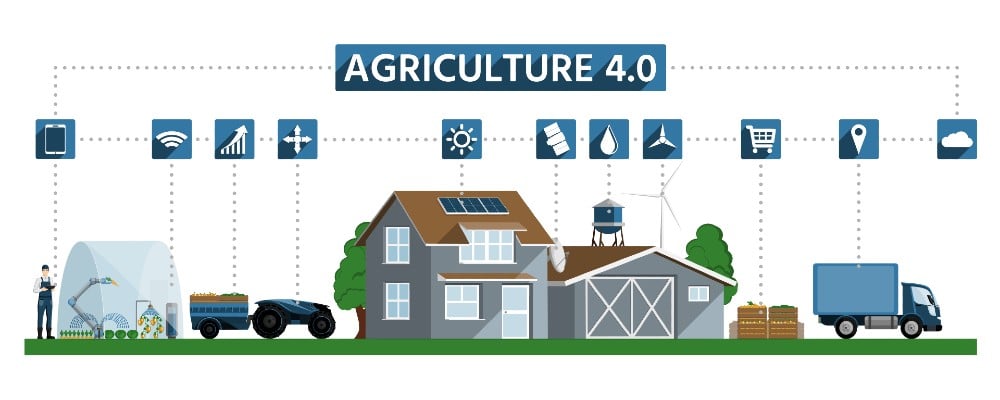- This topic is empty.
- AuthorPosts
- Febuari 19, 2025 at 12:43 um #570149

Industry 4.0 refers to the fourth industrial revolution, which integrates digital technologies, automation, and data exchange into production systems.
In agriculture, Industry 4.0 presents a transformative opportunity by using cutting-edge technologies such as the Internet of Things (IoT), Artificial Intelligence (AI), Big Data, robotics, and autonomous machinery to enhance productivity, efficiency, and sustainability.
Achieving Industry 4.0 in agriculture requires a shift toward digital tools and processes that optimize farm management and crop production. This article will explore how to integrate Industry 4.0 components into agriculture and the steps required to modernize agricultural practices.
1. Implementing Internet of Things (IoT) Technologies
The Internet of Things (IoT) is a fundamental technology in achieving Industry 4.0 in agriculture. IoT involves the use of sensors and connected devices to gather real-time data from various sources across the farm.
These sensors can monitor environmental conditions such as soil moisture, temperature, humidity, and light intensity, as well as track plant health and pest activity. By connecting these devices to a centralized system or cloud, farmers can access detailed information about their crops and make data-driven decisions.
Implementing IoT in agriculture allows for precision farming, where inputs such as water, fertilizers, and pesticides are used efficiently, leading to reduced waste and improved crop yields.
For successful implementation, farmers need to invest in IoT infrastructure, such as sensors, communication networks, and cloud platforms, to collect and analyze data.
2. Leveraging Big Data and Analytics for Decision-Making
Big data refers to the large volumes of data generated by IoT devices, weather stations, satellite imagery, and market trends. By collecting and analyzing this data, farmers can gain actionable insights that help optimize their farming practices.
Data analytics can improve decision-making in areas such as crop selection, irrigation scheduling, pest control, and harvest timing. For example, predictive analytics can forecast weather patterns, allowing farmers to plan their operations around potential weather events, reducing risk and improving productivity.
To achieve Industry 4.0 in agriculture, farmers must integrate big data systems into their operations. This includes adopting advanced analytics tools, machine learning algorithms, and cloud computing platforms that can handle large datasets and generate valuable insights.
3. Automating Farm Equipment with Robotics and Drones
Automation is a key component of Industry 4.0, and the integration of robotics and drones into farming is revolutionizing how tasks are performed. Automated tractors, harvesters, and planters can work around the clock, reducing labor costs and improving efficiency.
For example, autonomous tractors equipped with GPS and sensors can precisely plant seeds at optimal depths and spacing, ensuring uniform crop growth.
Additionally, drones equipped with cameras and sensors can monitor crop health, assess field conditions, and even apply fertilizers or pesticides with great precision.
Robotics also allows for labor-intensive tasks, such as picking fruits or pruning, to be done more quickly and consistently.
The adoption of these technologies in agriculture requires significant investment in robotic systems, drone equipment, and training for operators to ensure seamless integration into existing farming operations.
4. Integrating Artificial Intelligence (AI) and Machine Learning
Artificial Intelligence (AI) and Machine Learning (ML) play a significant role in achieving Industry 4.0 in agriculture by enabling advanced decision-making and automation.
AI systems can process vast amounts of data and provide insights into various aspects of farming, such as crop growth patterns, soil health, and disease detection.
For example, machine learning algorithms can analyze images captured by drones or satellites to detect early signs of crop diseases, allowing farmers to take preventive measures before significant damage occurs.
AI can also optimize resource management by adjusting irrigation schedules, managing nutrient levels, and predicting optimal harvest times.
Implementing AI and ML in agriculture requires access to high-quality data, computing power, and specialized software solutions that are capable of processing complex datasets and generating actionable recommendations.
5. Enhancing Connectivity and Digital Infrastructure
A critical component of achieving Industry 4.0 in agriculture is ensuring reliable connectivity and robust digital infrastructure. This involves the integration of high-speed internet, cloud platforms, and digital tools that allow farmers to access and share data in real time. The availability of fast and stable internet is particularly important for IoT devices, drones, and AI systems to communicate effectively.
In rural areas where connectivity may be limited, it is essential to invest in infrastructure that supports reliable communication networks, such as 4G/5G networks or satellite-based internet solutions.
Additionally, cloud computing plays a central role in storing and processing the large amounts of data generated by farm operations, enabling farmers to access information anytime and from anywhere.
Providing farmers with the tools and connectivity they need will help bridge the digital divide and make Industry 4.0 technologies more accessible to all.
Achieving Industry 4.0 in agriculture requires integrating advanced technologies like IoT, Big Data, robotics, AI, and automation into traditional farming practices. By adopting these technologies, farmers can optimize productivity, reduce waste, and improve sustainability.
However, achieving this transformation requires investment in digital infrastructure, technology adoption, and continuous education to ensure farmers are equipped to manage the new systems.
The implementation of Industry 4.0 components in agriculture will not only enhance farming efficiency but also contribute to food security, sustainability, and environmental conservation. With the right tools, training, and infrastructure, the future of agriculture will be increasingly digital, connected, and data-driven.
Read Also: Risk Mitigation for Removal of Pesticide Residues in Curry Leaf for Consumers
- AuthorPosts
- You must be logged in to reply to this topic.

